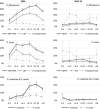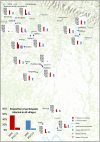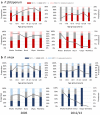The epidemiology of Plasmodium falciparum and Plasmodium vivax in East Sepik Province, Papua New Guinea, pre- and post-implementation of national malaria control efforts
- PMID: 32503607
- PMCID: PMC7275396
- DOI: 10.1186/s12936-020-03265-x
The epidemiology of Plasmodium falciparum and Plasmodium vivax in East Sepik Province, Papua New Guinea, pre- and post-implementation of national malaria control efforts
Abstract
Background: In the past decade, national malaria control efforts in Papua New Guinea (PNG) have received renewed support, facilitating nationwide distribution of free long-lasting insecticidal nets (LLINs), as well as improvements in access to parasite-confirmed diagnosis and effective artemisinin-combination therapy in 2011-2012.
Methods: To study the effects of these intensified control efforts on the epidemiology and transmission of Plasmodium falciparum and Plasmodium vivax infections and investigate risk factors at the individual and household level, two cross-sectional surveys were conducted in the East Sepik Province of PNG; one in 2005, before the scale-up of national campaigns and one in late 2012-early 2013, after 2 rounds of LLIN distribution (2008 and 2011-2012). Differences between studies were investigated using Chi square (χ2), Fischer's exact tests and Student's t-test. Multivariable logistic regression models were built to investigate factors associated with infection at the individual and household level.
Results: The prevalence of P. falciparum and P. vivax in surveyed communities decreased from 55% (2005) to 9% (2013) and 36% to 6%, respectively. The mean multiplicity of infection (MOI) decreased from 1.8 to 1.6 for P. falciparum (p = 0.08) and from 2.2 to 1.4 for P. vivax (p < 0.001). Alongside these reductions, a shift towards a more uniform distribution of infections and illness across age groups was observed but there was greater heterogeneity across the study area and within the study villages. Microscopy positive infections and clinical cases in the household were associated with high rate infection households (> 50% of household members with Plasmodium infection).
Conclusion: After the scale-up of malaria control interventions in PNG between 2008 and 2012, there was a substantial reduction in P. falciparum and P. vivax infection rates in the studies villages in East Sepik Province. Understanding the extent of local heterogeneity in malaria transmission and the driving factors is critical to identify and implement targeted control strategies to ensure the ongoing success of malaria control in PNG and inform the development of tools required to achieve elimination. In household-based interventions, diagnostics with a sensitivity similar to (expert) microscopy could be used to identify and target high rate households.
Keywords: Epidemiology; LLINs; Malaria; Malaria control; Plasmodium falciparum; Plasmodium vivax; Spatial heterogeneity.
Conflict of interest statement
The authors declare that they have no competing interests.
Figures



Similar articles
-
Monitoring Plasmodium falciparum and Plasmodium vivax using microsatellite markers indicates limited changes in population structure after substantial transmission decline in Papua New Guinea.Mol Ecol. 2020 Dec;29(23):4525-4541. doi: 10.1111/mec.15654. Epub 2020 Oct 16. Mol Ecol. 2020. PMID: 32985031 Free PMC article.
-
Differential impact of malaria control interventions on P. falciparum and P. vivax infections in young Papua New Guinean children.BMC Med. 2019 Dec 9;17(1):220. doi: 10.1186/s12916-019-1456-9. BMC Med. 2019. PMID: 31813381 Free PMC article.
-
High Rates of Asymptomatic, Sub-microscopic Plasmodium vivax Infection and Disappearing Plasmodium falciparum Malaria in an Area of Low Transmission in Solomon Islands.PLoS Negl Trop Dis. 2015 May 21;9(5):e0003758. doi: 10.1371/journal.pntd.0003758. eCollection 2015 May. PLoS Negl Trop Dis. 2015. PMID: 25996619 Free PMC article.
-
Malaria in Meghalaya: a systematic literature review and analysis of data from the National Vector-Borne Disease Control Programme.Malar J. 2018 Nov 6;17(1):411. doi: 10.1186/s12936-018-2563-3. Malar J. 2018. PMID: 30400879 Free PMC article.
-
Plasmodium vivax in the Era of the Shrinking P. falciparum Map.Trends Parasitol. 2020 Jun;36(6):560-570. doi: 10.1016/j.pt.2020.03.009. Epub 2020 Apr 22. Trends Parasitol. 2020. PMID: 32407682 Free PMC article. Review.
Cited by
-
Human and entomological determinants of malaria transmission in the Lihir Islands of Papua New Guinea: A cross-sectional study.PLoS Negl Trop Dis. 2025 Jan 3;19(1):e0012277. doi: 10.1371/journal.pntd.0012277. eCollection 2025 Jan. PLoS Negl Trop Dis. 2025. PMID: 39752628 Free PMC article.
-
Residual Malaria Transmission in Select Countries of Asia-Pacific Region: Old Wine in a New Barrel.J Infect Dis. 2021 Apr 27;223(12 Suppl 2):S111-S142. doi: 10.1093/infdis/jiab004. J Infect Dis. 2021. PMID: 33906222 Free PMC article.
-
Burden of Submicroscopic Plasmodium Infections and Detection of kelch13 Mutant Parasites in Military and Civilian Populations in Papua New Guinea.Am J Trop Med Hyg. 2024 Feb 20;110(4):639-647. doi: 10.4269/ajtmh.23-0508. Print 2024 Apr 3. Am J Trop Med Hyg. 2024. PMID: 38377613 Free PMC article.
-
Asia-Pacific ICEMR: Understanding Malaria Transmission to Accelerate Malaria Elimination in the Asia Pacific Region.Am J Trop Med Hyg. 2022 Oct 11;107(4_Suppl):131-137. doi: 10.4269/ajtmh.21-1336. Print 2022 Oct 11. Am J Trop Med Hyg. 2022. PMID: 36228917 Free PMC article.
-
Increase in the proportion of Plasmodium falciparum with kelch13 C580Y mutation and decline in pfcrt and pfmdr1 mutant alleles in Papua New Guinea.Malar J. 2021 Oct 19;20(1):410. doi: 10.1186/s12936-021-03933-6. Malar J. 2021. PMID: 34666779 Free PMC article.
References
-
- WHO . World Malaria Report 2019. Geneva: World Health Organization; 2019.
-
- Mueller I, Bockarie M, Alpers M, Smith T. The epidemiology of malaria in Papua New Guinea. Trends Parasitol. 2003;19:253–259. - PubMed
-
- Genton B, al-Yaman F, Beck HP, Hii J, Mellor S, Narara A, et al. The epidemiology of malaria in the Wosera area, East Sepik Province, Papua New Guinea, in preparation for vaccine trials I Malariometric indices and immunity. Ann Trop Med Parasitol. 1995;89:359–376. - PubMed
-
- Cattani JA, Moir JS, Gibson FD, Ginny M, Paino J, Davidson W, et al. Small-area variations in the epidemiology of malaria in Madang Province. P N G Med J. 1986;29:11–17. - PubMed
MeSH terms
Grants and funding
LinkOut - more resources
Full Text Sources
Miscellaneous

